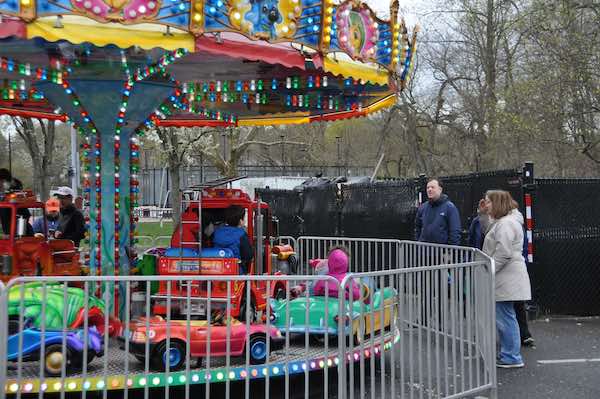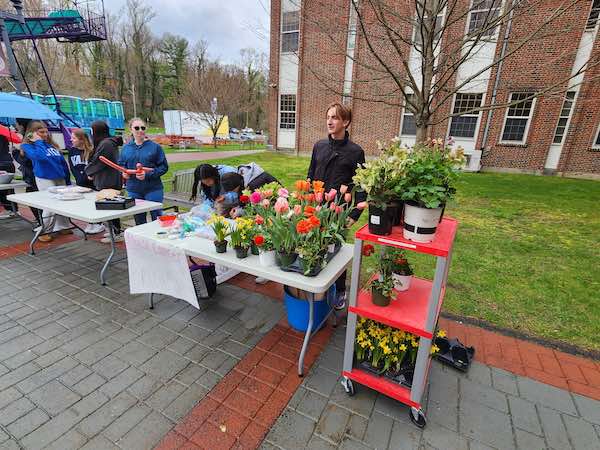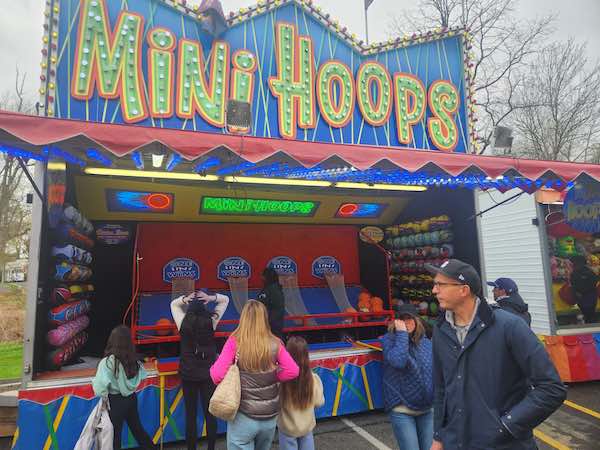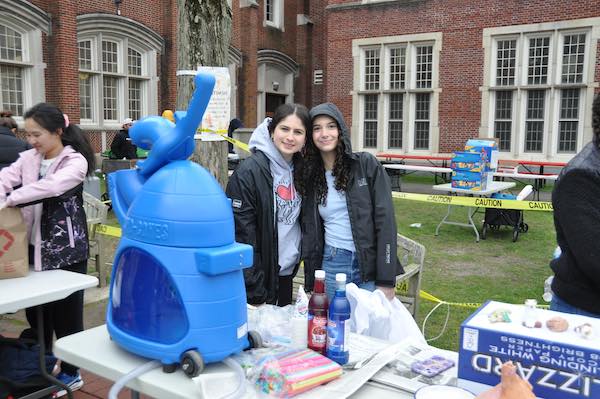Purchase Tickets for the Scarsdale Music Festival on June 1
- Details
- Written by Joanne Wallenstein
- Hits: 1211
 Tickets are on sale for the 4th Annual Scarsdale Music Festival (SMF), presented by Morgan Stanley. This exceptional, family-friendly community event will take place on Saturday, June 1st, rain or shine, in Scarsdale Village from 12-6pm, and will benefit Daniel’s Music Foundation. Join us for a festive day full of live music, food, drinks, and family fun activities for people of all ages.
Tickets are on sale for the 4th Annual Scarsdale Music Festival (SMF), presented by Morgan Stanley. This exceptional, family-friendly community event will take place on Saturday, June 1st, rain or shine, in Scarsdale Village from 12-6pm, and will benefit Daniel’s Music Foundation. Join us for a festive day full of live music, food, drinks, and family fun activities for people of all ages.
SMF is designed to bring the community together by celebrating its love of music with local bands and musicians who love to perform. This year’s incredible talent line-up includes Artie Tobia, Conversing with Oceans, Daniel & Gerry, The Del Bocas, Euphoria, George Dennehy, Hunter Road, Iolanta Mamatkazina, Jake Nielsen, Lauren Minear, Rennie Pincus & Friends, Saturday Saints, Skyfactor, Trinity, and Zac Hoina Trio. These spectacular bands will be performing on three live stages, presented by Advocate Brokerage with Pure Insurance, Houlihan Lawrence, and Pepe Auto Group.
SMF will feature a selection of savory and sweet offerings from Baked in Color, Bango Bowls, Chill Hawaiian Shave Ice, Crumbl Cookies, Longford’s Ice Cream, One Rare Italian Steakhouse, Pizza Vitale Truck, Poke Motion Food Truck, PopoJito, Scarsdale Uniformed Firefighters Association, Tipsy Taco Truck, and Wing King Truck.
Guests can wash down all that delicious food with a cool drink! Attendees 21+ can enjoy great beer and wine by the glass, available for purchase at two main bars. The Grand Tasting Village, presented by Amici dei Vini, will feature a selection of fine wines from around the world, spirit cocktails, craft beer, and food pairings from premier local restaurants. Guests will have the chance to taste, talk, and learn from industry experts in this uniquely curated tasting event. It is a VIP experience with prime stage viewing not to be missed. Participating vendors include Amici dei Vini, Dobbs & Bishop Fine Cheese, Meritage, Micheline, Miles the Prince, M.S. Walker, PopoJito, and Simple Motive Brewing Co.
This year’s enhanced Family Fun Zone will feature carnival games, face painters, arts and crafts, musical demonstrations, DIY and STEAM activities, sports, inflatables, and more! Participating vendors and community partners include Bach to Rock, Camp Hillard, Carnival Parties, Community of Play, Faces by Wells, GameTruck, Hoff-Barthelson Music School, JCC Mid-Westchester, Love 2 Learn NY, Pink Princess Nails, Rotary Club of Scarsdale, Scarsdale Forum, Scarsdale Public Library & Friends of the Scarsdale Library, School of Rock White Plains, SPCA Westchester, and Yellow Acorn Montessori. Fan favorite Scarsdale Police and Fire vehicles will also be present along with the Scarsdale Volunteer Ambulance Corps for safety tips, tours and more!
We are thrilled to continue our ongoing support of the Scarsdale Music Festival, an annual event our colleagues and thousands of people from Westchester and across the region have loved attending for the past four years,” said Sandra L. Richards, Head of Global Sports & Entertainment and Segment Sales & Engagement at Morgan Stanley. “This year’s exceptional lineup of musicians and artists will again highlight our collective love of music, food, and the arts, celebrating and bringing together our diverse community.”
Scarsdale Music Festival will be donating a portion of the proceeds to Daniel’s Music Foundation. Our donation will help provide access to free in-person and online music programs for deserving individuals with disabilities throughout the country.
“We are honored to have been selected as the 2024 beneficiary for The Scarsdale Music Festival,” said Daniel Trush Co-Founder and President at Daniel’s Music Foundation. “When we were first approached with the opportunity, it was obvious that there was great synergy between our organizations in our shared passion for using music to build community. Being able to showcase the talent of some of the artists from our record label, Just Call Me By My Name®, solidified that this was going to be a wonderful partnership,” echoed Ken Trush, Co-Founder and Managing Director of the Foundation.
TICKETS: There is a suggested donation of $20 per adult. Kids’ activity tickets are available for purchase to participate in most of the Family Fun Zone activities (one for $5, with discounted packages available). In order to consume alcohol, you must show ID to prove that you are over 21. Beer ($8) and wine ($10) will be available for purchase by the glass. Entrance to the Grand Tasting Tent requires a designated wristband ($35 on-site). All food and non-alcoholic beverages are pay-as-you-go.
This year’s SMF raffle features sought after guitars from Rudy’s Music and Martin Guitar, as well as gift cards for shopping and dining, certificates redeemable for health, beauty and wellness services as well as select tangible items. Raffle tickets may be purchased in advance or on-site (individually for $10 or packages of six for $50).
Donation Tickets, Kids’ Activity Tickets, Grand Tasting Village Wristbands, and Raffle Tickets are now on sale: scarsdalemusicfestival.com. Purchase tickets in advance online for discounted deals. Tickets will also be available for purchase on-site at the Festival by cash or credit card.
FREE PARKING is available in the Freightway Garage and adjacent outdoor parking lot (72 Freightway) as well as the lower two levels of the Christie Place.
For event information and tickets: www.scarsdalemusicfestival.com and follow us on Instagram @scarsdalemusicfestival. For sponsorship opportunities: info@scarsdalebusinessalliance.com.
For information about the Scarsdale Business Alliance: www.scarsdalebusinessalliance.com and follow us on Instagram @scarsdalebusiness.
To learn more about Daniel’s Music Foundation: danielsmusic.org.

Jacob Burns Film Center Opens Take 3 Wine Bar and Café
- Details
- Written by Joanne Wallenstein
- Hits: 1370
 Now you can have a bite and enjoy a movie at the Jacob Burns Film Center in Pleasantville. This month the Take 3 Wine Bar & Café was opened on the top floor of the theater. The new café marks the culmination of the recent theater renovation project.
Now you can have a bite and enjoy a movie at the Jacob Burns Film Center in Pleasantville. This month the Take 3 Wine Bar & Café was opened on the top floor of the theater. The new café marks the culmination of the recent theater renovation project.
Take 3 Wine Bar & Café’s menu includes sandwiches, salads, pastries, charcuterie, mac n’ cheese, pretzels, and baked goods from local businesses including Second Mouse Cheese Shop, Irving Farm, Posh Pretzels, Feel Good Booch—and renowned New York City restaurant Balthazar. The beer is sourced from the Captain Lawrence Brewing Company as well as Soul Brewing Company, along with cider from Thompson’s Cider Mill. The wines include a selection of reds, whites, rosés, and sparkling.
There’s kid-friendly fare as well as non-alcoholic beverage options, Take 3 Wine Bar & Café is also the perfect place for families to kick back and relax after a JBFC Kids Saturday screening.
Movie patrons can elevate their moviegoing experience by “coming early or staying late” to discuss films while enjoying food and drink with other filmgoers in a space designed by JBFC Board Member Laureen Barber (Pound Ridge), co-owner and designer of Blue Hill at Stone Barns. The JBFC also engaged a local architect, James Coleman (Pleasantville), on this project. Seating accommodates up to 85 people. Take 3 Wine Bar & Café is open to the public and ticketholders during the hours of operation on Thursdays from 4:00 to 10:00 and Fridays and Saturdays from noon to 10:00.
"Last spring, we completed renovations on our three original theaters, and now we are thrilled to introduce Take 3 Wine Bar & Café to our patrons,” said Mary Jo Ziesel, JBFC Executive Director. “This exciting addition reaffirms JBFC's commitment to being a dynamic cultural destination where art, community, and now a delightful selection of food and beverages come together. Our aim is to provide a welcoming space for our patrons to gather, converse, and savor moments before or after enjoying a film.”
"The expertise and creative touch of Laureen Barber, a dedicated board member, has been invaluable throughout this project. Laureen's design sensibility has truly shaped the ambiance and aesthetic of the space, transforming it into a place of comfort and elegance,” said JBFC Board Chair Lynn Sobel.
"I would like to extend my heartfelt gratitude to Ginny Gold, who has played an instrumental role in bringing our vision of the JBFC wine bar to life. Ginny has shown incredible generosity and foresight by choosing to honor Marty’s passion for wine in such a meaningful way, " added JBFC Board Chair Lynn Sobel.”
The installation also includes a new gallery which is now showing the private collection of Bill Gold—arguably the best movie poster designer of his time—this exclusive exhibit is curated by his widow and collaborator Susan Gold (New Canaan). It features one-of-a-kind original illustrations, alternate poster designs, and interesting behind-the-scenes stories spanning seven decades of iconic movie classics, from Casablanca to Mystic River. Visitors are encouraged to explore the exhibit and learn about Bill Gold's visionary approach to creating some of the world's most unforgettable movie posters. The Jane Peck Gallery, adjacent to Take 3, is open during Theater operating hours, seven days a week.
3,000 Eggs Gathered at Easter Egg Hunt
- Details
- Written by Joanne Wallenstein
- Hits: 874
 Over 3,000 eggs were picked up from the driving range during the annual Scarsdale Golf Club Easter egg hunt on Sunday March 31.
Over 3,000 eggs were picked up from the driving range during the annual Scarsdale Golf Club Easter egg hunt on Sunday March 31.
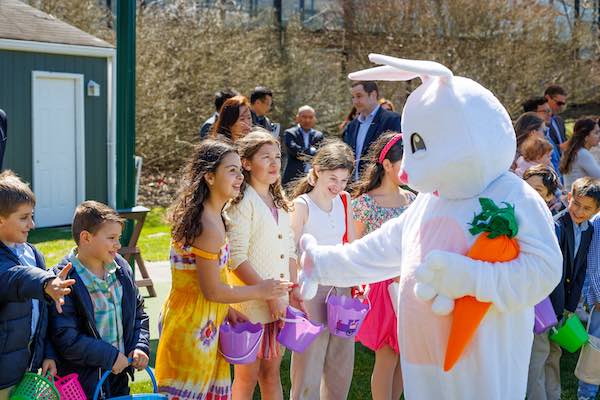
Over 150 kids participated with groups of toddlers ages 4 and under, another with kids 5-7 years old and another for kids ages 8 and up.

The Easter Bunny kicked off the event and posed for photos with kids and families before the dinner buffet.
The club hosted 500 members and guests for Easter Dinner.
(Photos by Mark Latham)





Fun Was Had By All at the SHS Carnival
- Details
- Written by Wendy MacMillan
- Hits: 1571
 Even cold, blustery weather couldn’t keep folks away from the fun tat the 22nd annual Scarsdale High School Carnival last weekend. The popular event, organized by the SHS Central School Government, had something for everyone to enjoy with carnival games, thrilling rides, and traditional snacks like cotton candy and funnel cakes. Exemplifying the District’s commitment to their motto Non-Sibi (not for oneself alone), the school government will donate their proceeds from the carnival to the Greenburgh Nature Center and Neighbors Link.
Even cold, blustery weather couldn’t keep folks away from the fun tat the 22nd annual Scarsdale High School Carnival last weekend. The popular event, organized by the SHS Central School Government, had something for everyone to enjoy with carnival games, thrilling rides, and traditional snacks like cotton candy and funnel cakes. Exemplifying the District’s commitment to their motto Non-Sibi (not for oneself alone), the school government will donate their proceeds from the carnival to the Greenburgh Nature Center and Neighbors Link.
The evening of Friday April 12th seemed to draw an older teenage crowd, with middle and high schoolers braving rides like Alien Abduction, Pharaoh’s Fury, and the Tornado. While some missed the classic carnival ride The Zipper, there was still plenty of fun to be had playing games such as Whac-A-Mole, Roll-A-Ball, and Mini Hoops with prizes like basketballs and stuffed animals to be won.
Saturday the 13th saw the carnival, run by Newtown Shows, full of families with younger children squealing with delight on rides like Super Round Up, Super Slide, and Puppy Role. Children of all ages enjoyed student-run games including the BullPen, the Dunk Tank, and the High Striker (hammer/ bell).
Putting a personal touch on the event’s amusements, SHS student clubs offered activities like a photo station complete with fun props, face painting, henna designs, balloon art and so much more. Other clubs such as the Spanish club offered churros for sale and the French club served crepes and cotton candy. In addition, the Gardening Club had spring plants for sale, the Breast Cancer Awareness Club offered bracelet making, and the Habitat for Humanity Club had a super sized Jenga to be enjoyed.
All of the students who participated in bringing these activities to life, and especially those in student government, should be proud of the hard work they put into organizing and hosting yet another amazing carnival for the community.
Scarsdale in WWII: Now Free to Watch Online
- Details
- Written by Joanne Wallenstein
- Hits: 1946
 A blood drive at Scarsdale Golf Club during WWIIOn Tuesday night March 26, the Scarsdale Historical Society held a screening of the film “Scarsdale in World War II,” to a packed audience in the Scott Room of Scarsdale Library. The movie was created and released by Scarsdale residents in 1946 and chronicles how Scarsdalians united and rallied in support of the war effort in the 1940s. It was produced and screened as part of a fundraising campaign for Jewish refugee children.
A blood drive at Scarsdale Golf Club during WWIIOn Tuesday night March 26, the Scarsdale Historical Society held a screening of the film “Scarsdale in World War II,” to a packed audience in the Scott Room of Scarsdale Library. The movie was created and released by Scarsdale residents in 1946 and chronicles how Scarsdalians united and rallied in support of the war effort in the 1940s. It was produced and screened as part of a fundraising campaign for Jewish refugee children.
The original 16mm film was found in storage at the Scarsdale Public Library, and all 1,200 feet of film has been digitized and preserved by the Scarsdale Historical Society. This historic treasure presents a stunning, visual testimony of Scarsdale life in the 1940’s. The footage captures Scarsdale’s landmarks as they appeared almost 80 years ago, including the only-known footage of some sites that no longer exist.
Proceeds from the screening of this film went to a national interfaith organization named “Children to Palestine.” The meaning behind this name requires some explanation, as it could cause some confusion in today’s context. When Jewish children were orphaned and displaced during the Holocaust, one of the few options for resettling them was the area then known as Palestine - before Israel became a nation in 1948. Moved by the plight of Jewish children, Scarsdale residents of all backgrounds united to rescue them from the “land of persecution” and bring them to a “Land of Promise.”
The Scarsdale branch of “Children to Palestine” was founded by two Scarsdale residents: Dorothy Silverstone (of 6 Richbell Close) and Susan Bennett (or 10 Elmdorf Drive). A Junior Committee was formed, and they sponsored the making of this film with the support of Dorothy Silverstone’s husband, Murray Silverstone, who was the President of 20th Century Fox. They were a very philanthropic couple, and it’s worth noting that with all of Murray’s accomplishments in the movie industry, this film was named in his obituary as one of his proud accomplishments.
It turns out that former Mayor Jane Veron was related to Silverstone. Veron explained, “Murray and Dorothy are my great uncle and aunt. My grandfather Emanuel Silverstone (my mom’s dad) also worked at 20th Century Fox. He would tell us stories about famous actresses like Elizabeth Taylor and Shirley Jones. Murray was his older brother. As a child, we used to visit Murray and Dorothy’s home/barn on Richbell Close for family events. We were regaled with stories from their days in the motion picture business.”
The Historical Society conducted research and detective work to identify some of the film locations and prominent residents, and provided this information in captions to help the audience connect and better understand the film. The film has now been posted online and is free to watch!
See wonderful footage of a party at Fox Meadow Tennis Club the night of the attack on Pearl Harbor, women of Scarsdale who swung into action for the war effort and sad stories of Scarsdale’s young men who did not return from the war.
The film was produced by stage producer Julian Olney and narrated by renowned broadcaster Lowell Thomas and is well worth watching here.















